The Intel Haswell-E X99 Motherboard Roundup with ASUS, GIGABYTE, ASRock and MSI
by Ian Cutress on September 25, 2014 11:30 AM ESTCPU Benchmarks
Readers of our motherboard review section will have noted the trend in modern motherboards to implement a form of MultiCore Enhancement / Acceleration / Turbo (read our report here) on their motherboards. This does several things, including better benchmark results at stock settings (not entirely needed if overclocking is an end-user goal) at the expense of heat and temperature. It also gives in essence an automatic overclock which may be against what the user wants. Our testing methodology is ‘out-of-the-box’, with the latest public BIOS installed and XMP enabled, and thus subject to the whims of this feature. It is ultimately up to the motherboard manufacturer to take this risk – and manufacturers taking risks in the setup is something they do on every product (think C-state settings, USB priority, DPC Latency / monitoring priority, memory subtimings at JEDEC). Processor speed change is part of that risk, and ultimately if no overclocking is planned, some motherboards will affect how fast that shiny new processor goes and can be an important factor in the system build.
For our tests today, it would seem that all the motherboards had some form of MultiCore Turbo, although because we are testing with a JEDEC memory kit, some are more ‘turned on’ than others. The GIGABYTE and ASUS motherboards seemed more content at stock and mid-turbo frequencies, whereas the MSI and ASRock were more aggressive.
Point Calculations – 3D Movement Algorithm Test: link
3DPM is a self-penned benchmark, taking basic 3D movement algorithms used in Brownian Motion simulations and testing them for speed. High floating point performance, MHz and IPC wins in the single thread version, whereas the multithread version has to handle the threads and loves more cores.
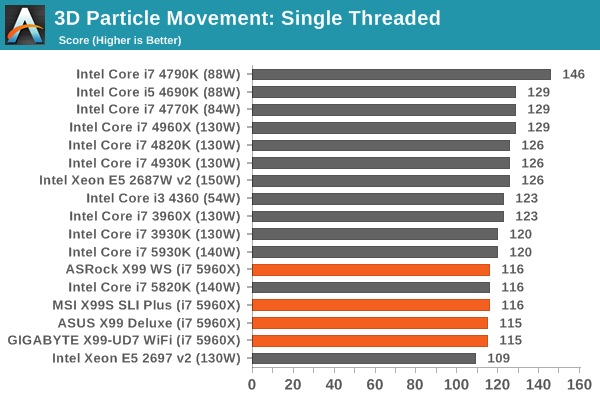
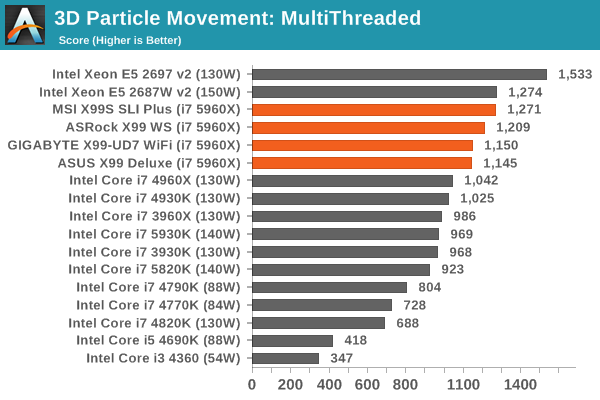
The MSI takes a commanding lead in the multi-threaded version of the test.
Compression – WinRAR 5.0.1: link
Our WinRAR test from 2013 is updated to the latest version of WinRAR at the start of 2014. We compress a set of 2867 files across 320 folders totaling 1.52 GB in size – 95% of these files are small typical website files, and the rest (90% of the size) are small 30 second 720p videos.
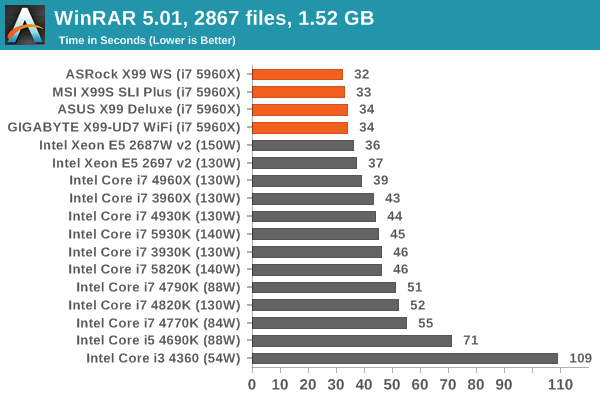
In comparison, the ASRock wins here.
Image Manipulation – FastStone Image Viewer 4.9: link
Similarly to WinRAR, the FastStone test us updated for 2014 to the latest version. FastStone is the program I use to perform quick or bulk actions on images, such as resizing, adjusting for color and cropping. In our test we take a series of 170 images in various sizes and formats and convert them all into 640x480 .gif files, maintaining the aspect ratio. FastStone does not use multithreading for this test, and thus single threaded performance is often the winner.
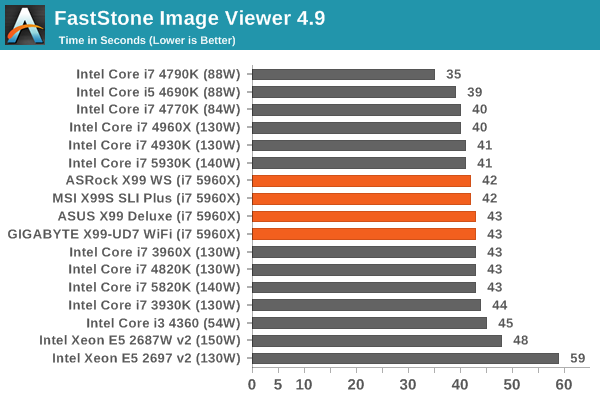
The split between MSI/ASRock against ASUS/GIGABYTE results in a one second gap in our FastStone test.
Video Conversion – Handbrake v0.9.9: link
Handbrake is a media conversion tool that was initially designed to help DVD ISOs and Video CDs into more common video formats. The principle today is still the same, primarily as an output for H.264 + AAC/MP3 audio within an MKV container. In our test we use the same videos as in the Xilisoft test, and results are given in frames per second.
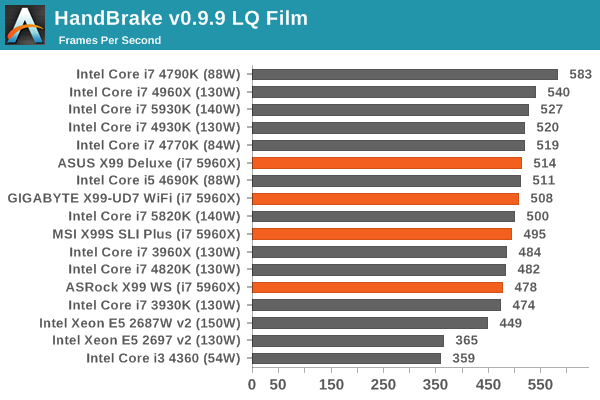

Interestingly here the ASUS and GIGABYTE pull ahead during the low quality test, but at 4K the ASRock scores the points.
Rendering – PovRay 3.7: link
The Persistence of Vision RayTracer, or PovRay, is a freeware package for as the name suggests, ray tracing. It is a pure renderer, rather than modeling software, but the latest beta version contains a handy benchmark for stressing all processing threads on a platform. We have been using this test in motherboard reviews to test memory stability at various CPU speeds to good effect – if it passes the test, the IMC in the CPU is stable for a given CPU speed. As a CPU test, it runs for approximately 2-3 minutes on high end platforms.
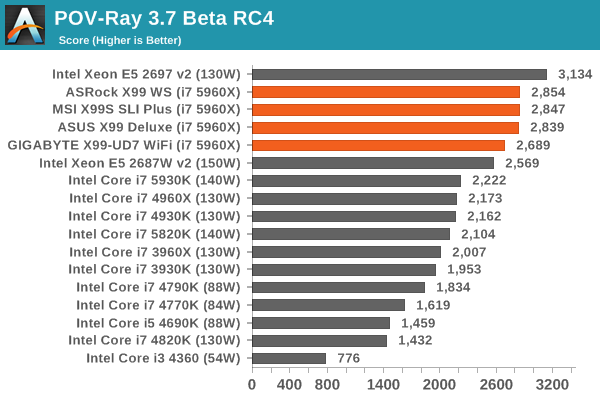
MultiCore Turbo affects motherboards more in tests such as POV-Ray, and the GIGABYTE drops down here.
Synthetic – 7-Zip 9.2: link
As an open source compression tool, 7-Zip is a popular tool for making sets of files easier to handle and transfer. The software offers up its own benchmark, to which we report the result.
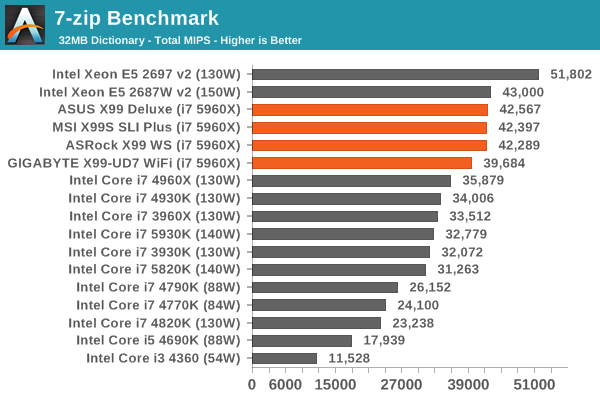










62 Comments
View All Comments
biostud - Thursday, September 25, 2014 - link
ASUS also has the X99-A at launch, at least here in Europe.isa - Thursday, September 25, 2014 - link
Ian, thanks for a great job overall on this article. I especially appreciated your clarity on how the PCIe and M.2 configs work.SanX - Thursday, September 25, 2014 - link
+1SanX - Friday, September 26, 2014 - link
Ian is on Liquid Nitrogen.The Monster-review :-)
icrf - Thursday, September 25, 2014 - link
Sounds like the Asus X99-A is the one for me. It keeps all the good stuff about the X99-Deluxe and saves $125. I don't need so many SATA or USB ports, I don't need wifi or dual GbE. I get the pile of fan headers and great sound, BIOS, and overclocking. Now I just need to know where the sweet spot is for memory count, speed, and timings. I suspect that's next on Ian's list.Eyeshield21 - Thursday, September 25, 2014 - link
Great roundup review. ASUS is falling lately. Did you guys heard about the burnt motherboard that their X99 had? I wonder how many people have this issue.The Von Matrices - Friday, September 26, 2014 - link
So somehow you have determined it is a great roundup without even reading the first page?The_Assimilator - Friday, September 26, 2014 - link
This is a really poor anti-ASUS shill comment.xunknownx - Thursday, September 25, 2014 - link
i have the MSI x99s sli plus and its great. its beautiful and feels premium. http://imgur.com/Q7u6qjDnot sure why the article say its not for overclockers. i overclocked my i7 5820k to 4.6ghz easily and its running stable. i don't need so many extra ports or wifi. at $230, its a great value for such an awesome board.
jay401 - Thursday, September 25, 2014 - link
Because then you won't spend twice the price for a more expensive board.